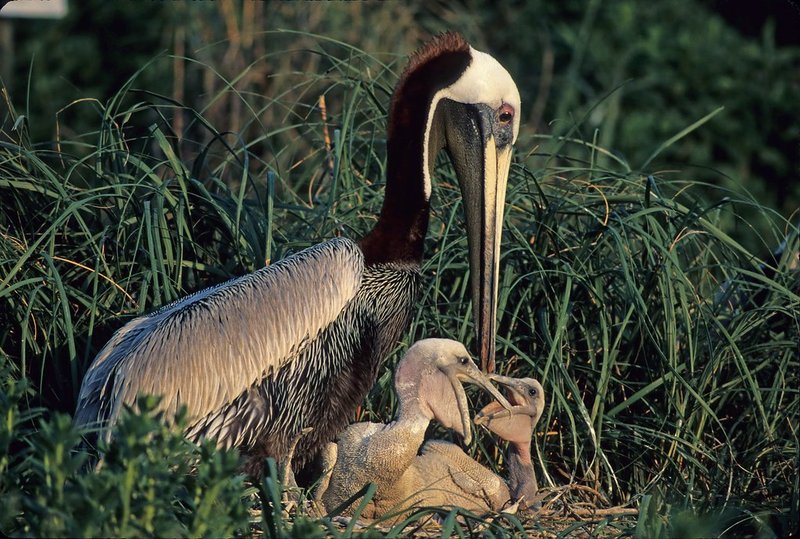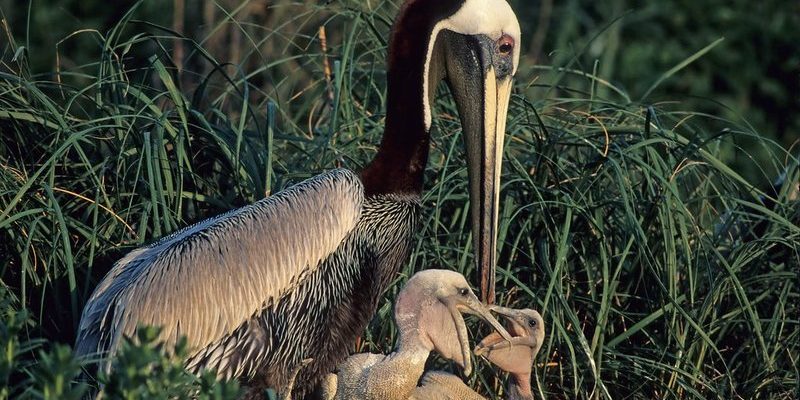
Imagine pelicans as dedicated parents, building their homes and nurturing their young ones in a way that can be both tender and tough. From picking the perfect nesting spot to raising their chicks, it’s a journey filled with challenges and triumphs. Here’s a peek into the world of pelican families and their nesting rituals, starting from courtship all the way to the first flight of their chicks.
Understanding Pelican Species and Their Habitats
There are several species of pelicans, but the most common ones include the American white pelican and the brown pelican. Each species has its own favorite nesting regions. The American white pelican, for example, typically prefers shallow lakes, marshes, and coastal regions. On the other hand, brown pelicans are often found along the coasts, nesting on sandy islands and cliffs.
These choices aren’t just random. Pelicans need locations that are safe from predators and rich in food sources. Their habits are deeply connected to their environments. You might wonder why they have such specific preferences. Honestly, it’s all about survival! In the wild, choosing the right spot can mean the difference between thriving and merely surviving.
The Nesting Ritual: Courtship and Pairing
Before pelicans even think about nesting, they go through a fascinating courtship process. During this time, males perform elaborate displays to attract females. This might include flapping their wings, making soft calls, and even showing off their beaks. It’s almost like a dance, a way for them to demonstrate their fitness as partners.
Once a pair forms, they stick together and work as a team. You might be wondering how they find a nesting location. Well, pelican couples often return to the same nesting grounds year after year, which speaks to their strong bonds. This familiarity helps them navigate the challenges of raising young in a potentially harsh environment.
Building the Nest: Materials and Location
When it’s time to build a nest, pelicans get to work. They typically use grass, sticks, and other plant materials to create a sturdy home. You could say they’re like tiny architects, carefully selecting materials that will help protect their eggs and chicks.
The location of the nest is just as crucial as the building materials. Pelicans prefer sites that are well-hidden from potential predators like foxes or raccoons. Some nests are built on small islands surrounded by water, while others may be in trees or shrubs. A well-placed nest not only protects the babies but also makes it easier for the parents to access food nearby.
The Egg-Laying Process and Incubation
Once the nest is ready, it’s time for the exciting part—laying eggs! Pelicans usually lay between two and four eggs, depending on the species and environmental conditions. These eggs are often white to light blue and are about the size of a large duck egg.
After laying the eggs, both parents take turns incubating them. This process lasts about 30 days. Here’s the thing: both parents share responsibilities, ensuring that the eggs are kept warm and protected. It’s a delicate balance, as they must also hunt for food. It’s a real team effort, showcasing the dedication of pelican parents to their future chicks.
Hatching: The Arrival of Pelican Chicks
When the hatching time arrives, you can imagine the excitement! Baby pelicans, called chicks, break out of their eggs ready to face the world. They’re born with a fuzzy, downy coat, and while they’re a bit awkward at first, they quickly adapt.
The first few weeks are critical. Chicks rely entirely on their parents for food, warmth, and protection. The parents will regurgitate food for the chicks, which might seem a little gross, but it’s a vital part of their diet. It’s almost like a restaurant experience, where the parents serve up fresh fish! This care helps the chicks grow rapidly, preparing them for their future lives as independent pelicans.
Growing Up: From Chicks to Juveniles
Throughout the summer, the chicks will grow and develop their feathers, transitioning from fuzzy babies into sleek, young birds. This stage is incredibly important. This is when they learn vital skills, like how to fly and where to find food in the water. You might be surprised to know that some pelican chicks can jump into the water and start practicing swimming while still somewhat awkward.
As the weeks go on, the adult pelicans teach their young about hunting. This involves a lot of trial and error since learning to catch fish is no easy feat! It’s a bit like how we learn through experience—sometimes you catch fish, and sometimes you miss. This combination of instincts and learned behavior ensures that the chicks are ready to fledge, or leave the nest, by the end of summer.
Fledging: The First Flight
Once the pelican chicks reach about 10 weeks old, it’s time for them to take their first flight. This moment is full of excitement and nervous energy. The parents encourage them to fly by moving around, sometimes even taking off into the air themselves. It’s a bit like a parent cheering their child on during a school play.
Initially, the young pelicans might have shaky flights; sometimes they even land in the water! But as they practice, their confidence grows. Once they master flying, these young pelicans slowly start to venture out on their own, learning how to feed themselves and navigate their environment independently.
The Lifelong Journey of Pelicans
As pelicans continue their journey, they’ll eventually return to their nesting grounds to start families of their own. Pelicans can live for about 10 to 25 years in the wild, depending on the species and environmental factors. Each year, they’ll go through the same rituals, contributing to the cycle of life.
Pelican nesting habits and lifecycle are a testament to the beauty of nature. They show us how interconnected life is—how each step in their journey is crucial for their survival. By understanding these amazing birds, we can appreciate the delicate balance of our ecosystems and the importance of protecting their habitats.
In conclusion, pelicans are not just fascinating to watch; their nesting habits and lifecycle are filled with lessons on dedication, teamwork, and survival. Watching them raise their young is a reminder of how nature works, and it can inspire us to protect these incredible creatures for future generations to enjoy.

